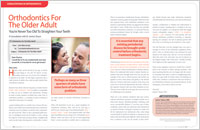What do orthodontists do?
Orthodontists are dental specialists who diagnose and treat problems with the position, alignment or spacing of the teeth, and related irregularities in the face and the jaw. We use a number of special treatments, including braces and other oral appliances, to correct these problems.
Why should I (or my loved ones) get orthodontic treatment?
There are two good reasons: aesthetics and function. Having an attractive smile not only changes the way people see you — it enhances your own self-image as well. Orthodontic treatment also allows your teeth to function better and makes it easier to keep them clean, which can improve your overall health.
When should orthodontic treatment be started?
You're never too old to begin orthodontic treatment — but if you start at an earlier age, your problems may be easier to treat. The American Association of Orthodontists recommends that a child who may need orthodontic treatment should come in for a first visit around age 7.
How can I recognize a potential bite problem?
Teeth that are protruding, crowded together or erupting out of position are clear indications that treatment is needed (View Examples). Less obvious signs are mouth breathing, frequent biting of the cheek or palate, speech difficulties, and thumb sucking that goes past 3-4 years of age. If teeth don't meet properly when the mouth closes, or if jaws make sounds or shift as they move, this may also indicate an orthodontic problem.
Does getting braces hurt? What about wearing them?
Having braces put on is generally painless. Some people experience minor aches and pains in the first couple of days or so, as they adjust to wearing their appliances; periodic adjustments may sometimes cause soreness as well, though it typically lasts only a short time. Over-the-counter pain relievers can be used to alleviate any discomfort, but are usually unnecessary.
How long will treatment take?
It's different for each person, but generally the active stage of treatment (that is, wearing braces or other appliances) may take from 6-30 months. After that, a retainer is worn.
How often will I come in for an appointment?
It depends on what's being done, and how often you need to be monitored. During active treatment, you'll typically come in to our office once every 4 to 10 weeks.
Will I need to have any teeth extracted?
If your teeth are severely crowded (because your mouth is too small to properly accommodate all of them) — or if you have impacted teeth (teeth that are trapped beneath the gum line by other teeth) — then extraction may be necessary. In the case of younger patients, early treatment may make extraction unnecessary.
Will I have to watch what I eat?
Yes — you should pass up the types of foods that could damage or become trapped in your braces. Some of these include raw vegetables, hard candy, caramel, taffy and ice cubes (fortunately, ice cream is OK). We will give you a list of foods to avoid.
Will I be able to play sports/ play my instrument?
In a word: Yes. Of course, whether you wear braces or not, we recommend you wear a mouthguard when playing most sports. Musicians are generally able to play their instruments just as they did before, but they may need a short adjustment period after getting braces.
Do I still need to see my regular dentist while I'm getting orthodontic treatment?
You do — in fact, it's more important than ever! Keeping teeth free of plaque (and potentially, decay) can be challenging when you're wearing braces. Your dentist can help you avoid these problems with frequent cleanings and exams.
Will I wear a retainer when my braces come off?
Almost always, the answer is yes: If you don't wear a retainer, your teeth can rapidly shift out of position — and then all the effort put into your treatment is lost! Your retainer helps you maintain that good-looking smile for a lifetime.
Is orthodontic care very expensive?
Orthodontic care is a long-term investment in your health and well-being. Yet its cost hasn't increased as fast as many other consumer prices, and many financing options are available that make orthodontic care affordable. Weighed against the true cost of living with problem teeth, orthodontic treatment can be a wise investment indeed.
Related Articles

The Magic of Orthodontics
Proper alignment of the teeth is basic to “Smile Design.” Their position dictates how they work together and affects the way you look and smile. Only orthodontic treatment can move teeth into the right position. Simply put, when things look right, they probably are right. Learn the basics of smile analysis and design and whether the magic of orthodontics will work for you... Read Article

Orthodontics for the Older Adult
Healthy teeth can be moved at any age, so there's no such thing as “too old” for braces. In fact, nowadays about one out of every five orthodontic patients is an adult. Yet this figure represents only a small portion of adults who could actually benefit from orthodontic treatment... Read Article